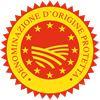Description
Formaggella del Luinese PDO is a semi-hard cheese produced exclusively with raw whole goat’s milk obtained from typical local Alpine breeds; Camosciata delle Alpi, Nera di Verzasca and relative cross-breeds.
Production Area
The production area of Formaggella del Luinese PDO is within the hilly and mountainous territory of 71 municipalities in the Northern part of the Province of Varese, in the Lombardy region.
Production Method
The goat’s milk is obtained from a maximum of three milkings; it must be stored at a temperature that does not exceed 4 °C and transformed within 30 hours of milking. The milk can be cooked over a wood or gas fire or steamed, reaching a temperature of 32-34 °C. Lactic bacteria and natural calf rennet are added to the milk before curdling; the curd is broken for 30-40 minutes and continues until the grains are about the size of a corn kernel. Shaping takes place in moulds with a diameter of 14 cm, after which the cheeses are drained for a maximum of 48 hours at room temperature, during which time they are turned 2-5 times to promote the expulsion of the whey. The wheels are dry salted or salted in brine, then dried at room temperature. Ripening is carried out in environments with a controlled humidity of 85-95% and a maximum temperature of 15 °C, or in cellars at room temperature, and lasts for a period of 40 to 60 days.
Appearance and Flavour
Formaggella del Luinese PDO has a rind that is not hard, with the possible presence of mould. The cheese is soft and firm, at times with small eyes, with a smooth, springy and relatively soluble consistency. It has a delicate, sweet flavour that becomes stronger as it matures.
History
Since ancient times, goat rearing in the Luinese Valley has traditionally been carried out by families, who donated, traded or sold, in the local markets, the cheese they produced. The first historical references to Formaggella del Luinese date back to some 16th and 17th century texts. In later documents, there are specific mentions of “small cheeses with a piquant flavour” obtained from the milk of the numerous goats that populated the Valtravaglia. After the Second World War, the rural areas were slowly abandoned, with the consequent loss of jobs in the mountains, including artisan cheese-making. In the Seventies, thanks to the rediscovery of typical products, there was a revival in goat breeding and deriving products in the Piedmont region.
Gastronomy
Formaggella del Luinese PDO should be kept in the refrigerator at a temperature of about 4 °C, inside suitable plastic or glass boxes which keep the cheese fresh and minimise odours. It can be eaten as a table cheese or used as an ingredient in typical local dishes, for example, Risotto with Formaggella del Luinese PDO and Mantuan pears, Alpine trout fillet with caramelised onion, Cold gnocchetti with fresh goat’s cheese and wafers of Formaggella del Luinese PDO and coloured goat’s cheese, where the Formaggella is mixed with goat’s milk and garlic until it reaches a stiff consistency, after which it is seasoned with tomato, wild rocket and walnut sauce.
Marketing
The product is marketed as Formaggella del Luinese PDO. It is sold year-round in whole rounds. The fire-branded logo must be impressed on the heel of the cheese.
Distinctive Features
The goats from which the milk used to produce Formaggella del Luinese PDO is obtained, remain at pasture for at least 7-8 months of the year, which is what gives the milk its unique characteristics.















